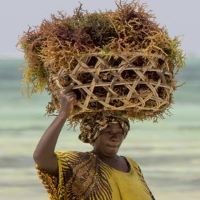

AquaInvest Platform
Authors
Tags
- Seaweed farming (17)
- Gender (3)
- Research (1)
- Biodiversity (1)
- Guidelines (1)
- Seaweed (24)
- Fishery (8)
- Environment, Disaster Risk, and Climate Change (1)
- China (1)
- Region - East Asia and Pacific (2)
- Agriculture (16)
- Korea (4)
- Ecosystem Services (3)
- Policy and Regulations (1)
- Climate Change Adaptation (4)
- Climate Resilience (5)
- Food Safety (3)
- Africa (2)
- Mariculture (21)
- Food Security (11)
- Policy - Food Security (4)
- Gender Equality (2)
- Blue Economy (30)
- Agribusiness (12)
- Climate Change (5)
- AFR Region (1)
- Environment (15)
- Policies and Legislation (2)
- Aquaculture (42)
- Indonesia (1)
- Nutrition & Diets (1)
- women (1)
Documents
FAO-WBG SPECIAL DAY, WAS AFRICA 2023: Unlocking the Potential of Sustainable Aquaculture in Africa
On the occasion of the Aquaculture Africa 2023 (World Aquaculture Society – African Chapter Conference, Lusaka, Zambia, 13–16 November 2023), the Food and Agriculture Organization of the United Nations (FAO),
The Potential of Green Aquaculture in Africa: Status and Prospects for Seaweed Farming
The note, published by The African Development Bank, reviews the most recent work and focuses on seaweed culture as part of a series on different forms of green aquaculture to
Selected publications on Aquaculture
Aquaculture and Food Safety Aquaculture practices to ensure safety of food produced from farmed aquatic animals A seafood risk tool for assessing and mitigating chemical and pathogen hazards in the
USAID Announcements at the 2022 Our Ocean Conference
Initiatives to Conserve and Protect Our Oceans The U.S. Agency for International Development (USAID) announced 24 new and ongoing initiatives to conserve and protect our oceans at the 2022 Our
Seaweed Production Companies in Korea: An Overview
Seaweed Production Companies in Korea: An Overview Park, C.S., Hwang, E.K. (2022). Seaweed Production Companies in Korea: An Overview. In: Ranga Rao, A., Ravishankar, G.A. (eds) Sustainable Global Resources Of
Shaping investment guidelines for sustainable aquabusiness development – a work in progress
Authors: Ruth Garcia Gomez, and Julie Mollins As aquatic food consumption increases to meet demand from population growth and dietary preferences, so does recognition that the sector has a key role to
Social and economic dimensions of carrageenan seaweed farming
Carrageenan seaweed farming based primarily on the cultivation of Kappaphycus and Eucheuma species has grown significantly in the Philippines and Indonesia in the last two decades. Growth has also taken
Global seaweed farming and processing in the past 20 years
Seaweed has emerged as one of the most promising resources due to its remarkable adaptability, short development period, and resource sustainability. It is an effective breakthrough to alleviate future resource
Deep-sea Atlas of the Eastern Mediterranean Sea: state-of-the-art knowledge for better protection
The IUCN Centre for Mediterranean Cooperation and the Hellenic Centre for Marine Research present the Deep-sea Atlas of the Eastern Mediterranean Sea - the first collective work to compile the
Interventions for improving the productivity and environmental performance of global aquaculture for future food security
Volume 4, Issue 9, 17 September 2021, Pages 1220-1232 Aquatic foods are increasingly being recognized as having an important role to play in an environmentally sustainable and nutritionally sufficient food system.